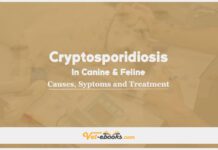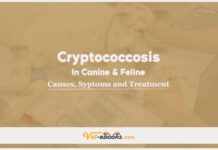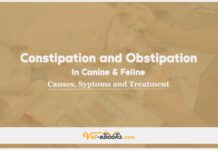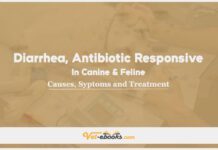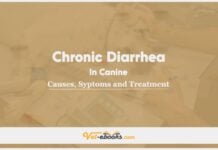Chronic Diarrhea In Feline: Causes, Symptoms and Treatment
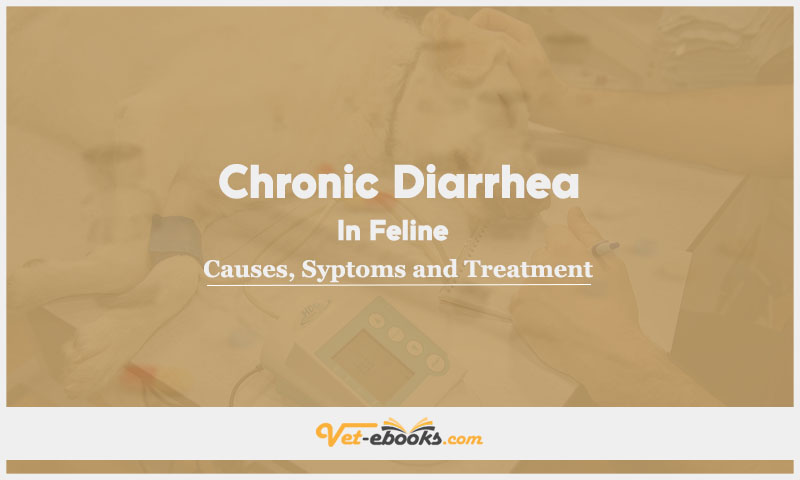
Overview
- Prolonged alteration in the frequency, regularity, and quantity of stool beyond 3 weeks or exhibiting a pattern of intermittent recurrence.
- Classified as either small bowel, big bowel, or a combination of both.
Causes of Chronic Diarrhea In Feline
Causes
Small and Large Intestinal Diseases
- IBD (lymphoplasmacytic enteritis, eosinophilic enteritis, and granulomatous enteritis).
- Neoplasia (lymphoma, adenocarcinoma, and mast cell neoplasia).
- Bacteria (Salmonella, E. coli, and other enterobacteriaceae, as well as Clostridia).
- Viral infections (enteric coronavirus, feline infectious peritonitis, FeLV-linked diseases, and FIV-associated diseases).
- Mycotic infection (histoplasmosis).
- Algal infections (protothecosis and pythiosis).
- Parasites (Giardia, Toxocara, Ancylostoma, Toxascaris leonina, Cryptosporidium, Cystoisospora, and Tritrichomonas foetus).
- Partial blockage (foreign object, intussusception, or tumor).
- Secondary lymphangiectasia.
- Intestinal microbial dysbiosis.
- SBS.
- Gastrointestinal ulceration (rare in felines).
- Hepatobiliary disease (absence of bile salts, which are essential for the process of intraluminal digestion).
- EPI.
Dietary
- Dietary intolerance, specifically food-responsive diarrhea.
- Food allergy.
Metabolic Disorders
- Hyperthyroidism.
- Cobalamin deficiency.
- Renal disease
- Hepatobiliary disease.
- Adverse drug reactions (ADRs).
Congenital Anomalies
- Short colon.
- Portosystemic shunt.
- Persistent pancreaticomesojejunal ligament.
Risk factors
- Modifications in diet.
- Poorly digested or high-fat meals.
Pathogenesis of Chronic Diarrhea In Feline
- Excessive solute and fluid secretion results in secretory diarrhea.
- Low solute and fluid absorption results in osmotic diarrhea.
- Increased intestinal permeability.
- Abnormal GI motility.
- Numerous cases include diverse mixtures of these four fundamental pathophysiologic systems.
Symptoms (History & Physical Examination) of Chronic Diarrhea In Feline
History
- Small-bowel diarrhea (normal to increased volume of stool, normal to increased frequency of defecation, weight loss, polyphagia, melena, borborygmus, and varying episodes of vomiting).
- Large-bowel diarrhea (smaller volume of stool and increased frequency of defecation).
- Hematochezia and mucus, as well as tenesmus, urgency, and dyschezia.
Physical Examination
Small bowel
- Inadequate physical health due to malabsorption, maldigestion, and protein-losing enteropathy.
- Variable dehydration.
- Abdominal palpation identifies segmental or diffusely thickened small bowel loops.
- Rectal palpation does not yield any notable findings.
Large bowel
- Normal parameters.
- Dehydration (infrequently).
- Abdominal palpation identifies a thickening large bowel, foreign body, neoplastic mass, intussusception, or swollen mesocolic lymph nodes.
- Rectal palpation identifies irregularities, tumors, rectal strictures, or sublumbar lymphadenopathy.
Diagnosis of Chronic Diarrhea In Feline
1- From History and Physical Examination
2- Diagnostic Procedures
CBC
- Stress leukograms.
- Leukocytosis accompanied by neutrophilia and the presence of bands.
- Leukopenia.
- Eosinophilia in parasitic infestations or allergic conditions.
- Anemia induced by FeLV or hyperthyroidism.
- Microcytic nonregenerative anemia.
- Thrombocytopenia in FeLV cases.
- Thrombocytosis.
BIOCHEMISTRY
- Elevation in BUN levels.
- BUN levels decrease in liver failure or portosystemic shunts.
- Advanced CKD leads to gastrointestinal manifestations and dehydration, which are assessed by interpreting urine specific gravity (USG) in relation to creatinine levels.
- Hepatobiliary disease is associated with elevated levels of serum cholesterol and the presence of chronic diarrhea.
- The drop in serum cholesterol levels is attributed to maldigestion, malabsorption, and hyporexia.
- Phosphorus concentrations are elevated in hyperthyroidism and renal impairment.
- Those with maldigestion and malabsorption exhibit decreased levels of serum phosphorus.
- Elevated total protein levels.
- Neoplasia leads to hyperglobulinemia.
- Elevated liver enzymes, specifically ALT and ALP, indicate hepatobiliary illness.
- The co-occurrence of chronic enteropathy, hepatobiliary illness, and pancreatitis is known as triaditis.
- Bilirubin level elevation is an indicator of hepatobiliary illness and/or triaditis.
URINALYSIS
A USG test should be part of every basic database, and it should be compared to levels of BUN, creatinine, albumin, and total protein to rule out renal disease.
OTHER LABORATORY TESTS
Histoplasma antigen testing
- For felines who traveled to regions endemic to the disease.
- Exhibits cross-reactivity with Blastomyces antigens; a positive test result could potentially indicate either histoplasmosis or blastomycosis.
Thyroid testing
- Elevated concentrations of total T4 or free T4 indicate hyperthyroidism.
- If hyperthyroidism is suspected despite normal T4 levels, conduct a T3 suppression test, repeat the T4 test after a few months, or undergo a technetium scan of the thyroid glands.
Serologic testing
- Do tests for FeLV and FIV, particularly in cases with hematologic abnormalities.
Fecal testing
- Protozoal trophozoites, such as Cystisospora, Giardia, and Toxoplasma, are detected using direct smear analysis.
- Fecal flotation or zinc sulfate flotation techniques to detect protozoal trophozoites.
- In addition to fecal flotation using zinc sulfate, diagnostic methods for detecting Giardia include ELISA, PCR, and IFA testing.
- T. fetus is detected through PCR or in-house culture.
- Bacterial culture.
GI tests
- The presence of cells or fungal organisms within the mucosal lining interferes with the absorption of cobalamin.
- EPI reduces the secretion of intrinsic factor and dysbiosis, both of which can contribute to a drop in blood cobalamin levels.
- In cats with chronic diarrhea and hypocobalaminemia, collect ileal samples during the biopsy of the intestinal tract by ileocolonoscopy or surgical methods.
- For cats with hyperthyroidism, measure tT4 levels before any invasive diagnostic procedures.
- Folate levels may be reduced due to infiltrative mucosal diseases.
- Dysbiosis results in elevated serum folate levels.
Pancreatic tests
- Feline pancreatic lipase immunoreactivity (fPLI) is elevated in cases of pancreatitis.
- Feline trypsin-like immunoreactivity (fTLI) is reduced in patients with EPI.
- Patients undergo fasting for 12–18 hours before blood collection.
- TLI levels are elevated in cases of pancreatitis.
Imaging
- Abdominal ultrasonography reveals bowel wall thickening, abnormal intestine wall layering, masses, intussusception, foreign bodies, ileus, fluid accumulation, hepatobiliary illness, renal disease, or enlargement of lymph nodes.
- Abdominal radiography indicates intestinal blockage, abnormal intestinal patterns, organomegaly, masses, foreign bodies, pancreatic, hepatobiliary, or urinary diseases, or abdominal effusion.
- Chronic diarrhea has a low output.
- Despite the presence of substantial diffuse gastrointestinal disease, radiographs, and ultrasound may appear normal.
- In the presence of abnormal findings, ultrasound imaging can be utilized to ascertain the most optimal course of action.
- If diffuse mucosal disease is suspected, endoscopy is the optimal approach for further explaining the pathological characteristics of the disease.
- Surgical biopsies for extraluminal lesions, which refer to abdominal masses or lesions that are located outside the visual range of the endoscope.
3- Differential Diagnosis
- Renal disease.
- Hepatopathy.
- Hepatobiliary disease.
- Portosystemic shunt.
- Pancreatic disorders.
- Adverse drug reaction.
- Hyperthyroidism.
- Hypoadrenocorticism.
- FIV, FeLV, and FIP.
- Neoplasia.
- Dietary indiscretion, dietary changes, dietary intolerance, and dietary hypersensitivity.
- Dietary-responsive enteropathy, fiber-responsive enteropathy, antibiotic-responsive enteropathy, and steroid-responsive enteropathy.
Treatment of Chronic Diarrhea In Feline
General:
- The treatment and prognosis depend on the specific underlying condition.
- It is possible to do an empirical therapy trial with food, probiotics and prebiotics, antibiotics, and immunosuppressant drugs in a certain order if a definitive diagnosis cannot be made.
- In felines with IBD, lymphoma, or other neoplastic conditions, achieving complete and prolonged remission may not always be feasible, and instances of flare-ups may arise.
Medications:
- Emodepside/praziquante topically for roundworms, hookworms, and tapeworms.
- Epsiprantel orally for tapeworms.
- Imidacloprid/moxidectin topically for roundworms, hookworms, and Diroflaria immitis.
- Milbemycin oxime orally for roundworms, hookworms, and Dirofilaria immitis.
- Praziquantel orally for tapeworms.
- Praziquantel/pyrantel pamoate orally for roundworms, hookworms, and tapeworms.
- Selamectin topically for roundworms, hookworms, and Dirofilaria immitis.
- Fenbendazole and Metronidazole for giardia.
- Sulfadimethoxine, Toltrazuril, and Ponazuril for Cystoisospora.
- Ronidazole for T. Foetus.
- Probiotics, such as Proviable®.
- Prebiotics, such as Psyllium.
- cyanocobalamin (250 µg/cat SQ).
- Mirtazapine.
- Maropitant.
- Tylosin (10–40 mg/kg).
Some Notes:
- Anticholinergics should be avoided for empiric treatment as they worsen most forms of persistent diarrhea.
- Opiate diarrhea medicines make cats hyperactive and slow down their breathing. limit their administration to a maximum duration of three days.
Tip
Do You Want To Increase Your Veterinary Knowledge and Practical Skills?
You Can Now Browse and Download +3000 Books For Veterinary Professionals & Students Online.
Download Veterinary Books

